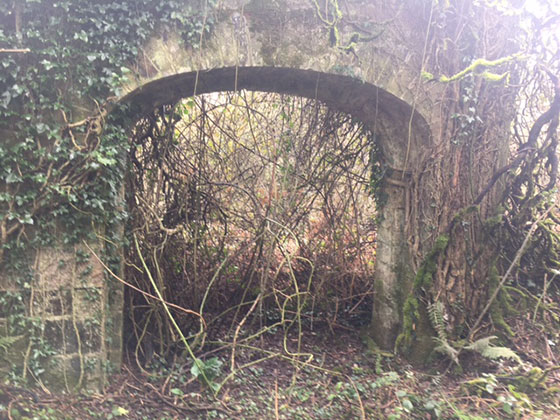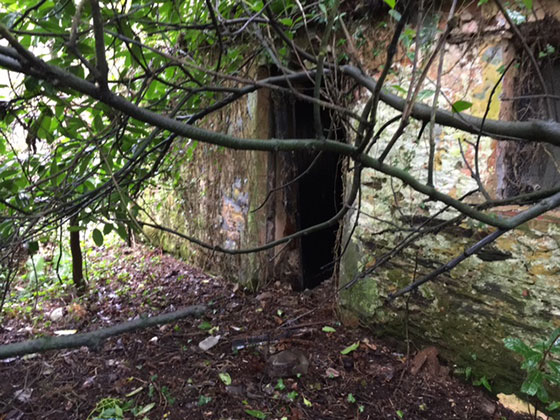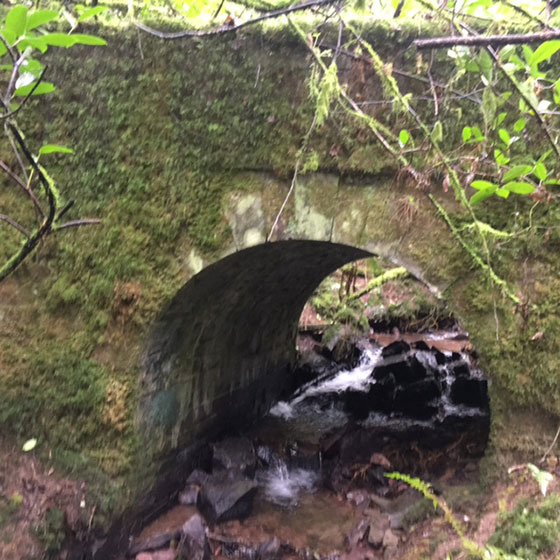PORTLAW, IRELAND – We spent the weekend exploring our new property, meeting neighbors, and getting to know the country.
We had seen our new house. But not the land. So we put on a pair of “wellies” and went to have a look.
“There are ruins out there,” Declan, the custodian of our new cottage, told us. “But they’re all covered up by vines. Nooo… body still alive can tell you what they were.”
 Bill stumbles upon ruins near his new Irish home
Bill stumbles upon ruins near his new Irish home
 An abandoned cabin
An abandoned cabin
 An ancient bridge
An ancient bridge
“Ireland is not nearly as simple as you Americans think,” explained a neighbor, Lord Tyrone.
“It’s a complex society with a very complex history.”
Law of Ignorance
On Monday, U.S. markets were closed for Presidents’ Day.
So we will use this quiet time to connect some old dots; we may learn something that will help us connect the new ones.
Long-term Diary sufferers will recall our Law of Ignorance: Ignorance increases by the square of the distance, in time and space, from the events.
In faraway North America, looking back hundreds of years, Irish history is simple: The English invaded and put the Irish under their yoke. The brave Irish spent centuries fighting for their independence.
But there were important sub-themes, counter-narratives, and confusions. We take a few minutes this morning to review…
Britain was the rising, hegemonic power in the 17th century. Not yet the “indispensable nation,” its troops, merchants, adventurers, and colonists were spreading out, imposing themselves in Scotland, Ireland, and North America.
Settlers from Britain had already been coming to Ireland for 600 years. Most had been assimilated into the Irish culture.
They learned the language (Gaelic) and became, in the words of the English, “more Irish than the Irish themselves.”
That was not a compliment. In the medieval period, the Irish regarded themselves as sophisticated as anyone. But the Renaissance was slow to arrive in remote Ireland. And the Reformation never did.
As for the English, many looked upon the Irish as scarcely human. They believed the Irish language and culture were primitive. And they considered Ireland, in the words of a famous American, to be a “sh*thole country.”
British colonists, backed by troops, set up “plantations” and encouraged Protestants (mainly from Scotland) to settle there – much as they were doing at the same time in the New World.
They treated the Catholic Irish not unlike the Indians they encountered in North America – to be ignored, converted, or exterminated.
In the battles that followed, more than a million people died. Many were massacred; many more starved to death as a result of England’s scorched-earth tactics. Observers from England and America reported scenes of desperation and misery almost beyond belief.
(In the 19th century, escaped slave Frederick Douglass from Maryland, visited Ireland. He was appalled. He wrote: “Of all the places to witness human misery, ignorance, degradation, filth, and wretchedness, an Irish hut is pre-eminent.”)
Suspicious of History
We are suspicious of all history.
It records little of what actually happened and is subject not only to our Law of Ignorance, but also to “victors’ spin” – the tendency to see all events as parts of an inevitable march of progress, leading to the present disposition of power and money.
After all, it is “public information,” based on fake news, misinformation, and a generous dollop of BS.
By the 17th century, Ireland was a mixture of several cultural and linguistic groups. There were the Old English and the New English. There were the descendants of the Vikings, mainly around Dublin and other port cities.
And there were recent immigrants from France – the Huguenots, Calvinist Protestants who fled persecution in Catholic France after the revocation of the Edict of Nantes.
And there were the Gaelic-speaking Irish, who had various regional, clan, and cultural rivalries. Even to this day, there are three separate dialects of the Irish language, barely intelligible one to another.
Religious differences were important, too.
Religion was to the 17th century roughly what political ideology is to today. People defined themselves by it. And although perhaps reluctant to die for it, they were certainly ready to kill for it.
By the late 1600s, there were Catholics – the majority of the population – along with Church of Ireland Protestants (Catholic, but not Roman papists), Presbyterians (concentrated in Ulster), and Quakers.
But it was the Roman Catholics who were considered the most dangerous. Irish Catholicism was seen as a threat to English power. Catholic France lay to the East, Catholic Spain to the South, and Catholic Ireland to the rear.
The Earl of Tyrone
Not that Ireland posed much of a threat.
But the Irish had close contacts on the continent. If the French were to establish a strong presence in Ireland, it might pose a strategic problem for England.
At least, that is what they seem to have thought. Or said they thought. Or thought they should think.
Conquerors are rarely interested in the particularities of the people they conquer. Or in delicate judgments about them.
And the reasons given for imposing themselves are usually brought out, like an infant to a foundling hospital, as a consequence of mischief, not a cause.
As we concluded in our book Empire of Debt, countries expand and conquer when they are able. The explanations are collected along the way:
“Make the World Safe for Democracy.” “Japanese Co-Prosperity Sphere.” “Bring the one true faith to the heathen.” “Take the light of democracy to the world.” “Lebensraum.”
In the late 16th and early 17th centuries, England was on the road to conquest. Ireland lay in its path.
Poor Hugh O’Neill. We tell his story because it illustrates the complexity of the rest of the story and helps explain what came later.
O’Neill may or may not have been the legitimate heir to his grandfather’s Gaelic title. Some claimed his father was adopted. Some claimed he was a bastard.
The English called him the Earl of Tyrone. The Tudor government in London attempted to bring Ireland under control by co-opting its Gaelic chiefs and turning them into loyal vassals of the crown.
It was not as though Hugh was an untainted Celt or a humble, bog-trotting peasant. He had been raised in England as a protégé of Queen Elizabeth I.
And he later had made himself useful to the English administrators in Dublin, notably by massacring the Spanish soldiers and sailors who washed up on the coast after the destruction of the Grand Armada.
He had also fought on the English side in the Munster rebellion of 1580… and with the English against the Scots in Ulster.
But when O’Neill went through the ancient ritual of becoming “The O’Neill,” the English turned against him.
Flight of the Earls
O’Neill appealed to the Spanish for help. He said he was fighting in the name of Catholicism. This was a little like Donald Trump asking for the support of evangelical Christians.
O’Neill had never been very religious and had formerly been a member of the Church of England.
The English sent an army of 17,000 men under the Earl of Essex. O’Neill’s rag-tag army was no match for them. But finally, the Spanish arrived, landing in the far southwest of the country.
Alas, this was a bad strategic position. English troops were able to bottle them up on the peninsula. O’Neill rushed south to attack the English rear. But then bad communications, bad leadership, or simply bad luck brought disaster.
An unexpected cavalry charge by Sir Charles Blount broke O’Neill’s lines and caused his army to flee in panic. O’Neill lost the Battle of Kinsale, and any hope of breaking the English grip on the island.
When the going gets tough, however, the tough get going – to Europe!
Hugh O’Neill and his main ally, Hugh Roe O’Donnell, slipped away with their families and retainers at midnight on September 14, 1607.
This became known as the Flight of the Earls. Then, as before and after, Irishmen frequented foreign courts and universities.
They tilled foreign soil. They worked in foreign industries. They made wine in Bordeaux and raised sheep on the Pampas. They offered their services to foreign armies… and supplicated their hosts to help them take back their homeland.
But the foreign liberators never came. O’Neill died in Rome in 1616. It was more than 300 years before the Irish Free State was established.
Regards,
![]()
Bill
Product of the Diaspora
Category: Geopolitics

